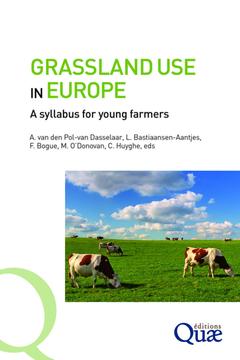Description
Grassland use in Europe
A syllabus for young farmers
Authors: van den Pol-van Dasselaar Agnes, Bastiaansen-Aantjes Leanne, Bogue Fergus, O Donovan Michael, Huyghe Christian
Language: French
Subject for Grassland use in Europe:
49.00 €
In Print (Delivery period: 3 days).
Add to cart264 p. · 16x24 cm · Paperback
Description
/li>Contents
/li>Biography
/li>
Covering 40% of the European agricultural area, grasslands are vitally important both for agriculture and society. These grasslands serve multiple functions, including the local provision of fodder for animal husbandry (and hence high-quality food provision for people), biodiversity conservation, carbon storage and the provision of ‘traditional’ landscapes that European citizens appreciate for recreational purposes and cultural heritage.
The future of grassland farming in Europe is in the hands of young farmers. Compared to other topics, grassland management has often been a weak point of teaching delivered by agricultural technical schools in several European countries. The training of future farmers and advisors could thus be significantly improved, which could lead to better grassland management in the medium and long terms. For this reason, the European project Inno4Grass created a syllabus and a set of PowerPoint presentations on practical grassland management for current and future generations of grassland farmers and advisors.
Preface
Objectives of Inno4Grass
Diversity of European grasslands
Main grassland types
Economic and social importance of European grasslands
Environmental importance
Threats
Chapter 1. Grassland production
Characteristics of grass
Use of grasslands
Grassland species and sward assessment
Weed management
Chapter 2. Grazing management
Grass supply
Main parasitic diseases encountered on the pasture
Main grazing parameters
Management according to the season
Farm infrastructure
Chapter 3. Hay and silage making
Cutting management and haymaking
Silage
Techniques adapted to legume and legume mixtures
Chapter 4. Soil and nutrient management
Soil characteristics related to grasslands
Main macro-nutrients: N P K
Biological nitrogen fixation
Liming
Use of animal manure
Other macro- and micronutrients
Chapter 5. Environment and biodiversity
Carbon sequestration
Greenhouse gas emissions
Water quality
Biodiversity
Chapter 6. Quality of grassland-based animal products
Milk and dairy product quality
Effect of grazed grass on milk composition
Effect of the grass conservation type on milk composition
References
Characteristics of individual countries
Sweden
Ireland
The Netherlands
Belgium
Germany
Poland
Agnes van den Pol-van Dasselaar is professor Grassland and Grazing at Aeres University of Applied Sciences in Dronten, the Netherlands. In the last 25 years, she has been researching grazing, ecosystem services, grass and forage management, greenhouse gas emissions and sustainable production systems. She is leading the Working Group “Grazing” of the European Grassland Federation.
Leanne Bastiaansen-Aantjes is lecturer and researcher at Aeres University of Applied Sciences in Dronten, the Netherlands. She has been part of the research team since 2017. Her main focus is on grazing and grassland management.
Fergus Bogue works at Teagasc, the Irish Agriculture and Food Development Authority. Its mission is to support science-based innovation in the agri-food sector and wider bio-economy that will underpin profitability, competitiveness and sustainability.
Michael O’Donovan, is Head of Grassland Science since 2008 in Teagasc, he has over 110 Peer Reviewed scientific publications in the area of Grassland. He is based at Teagasc Moorepark. He continues to promote efficient grassland management and utilisation as key practise for Irish and European grassland farmers.
Docteur ingénieur agronome de l’École nationale supérieure agronomique de Rennes, Christian Huyghe, directeur de recherche en génétique et amélioration des plantes de l’Inra, est aujourd’hui directeur scientifique Agriculture de l’Inra. Les problématiques liées à l’évolution des systèmes de production, mobilisant les leviers de la génétique et génomique animale et végétale, du biocontrôle et du numérique au service d’une agriculture multiperformante sont au cœur de sa mission, également enrichi par l’animation du partenariat avec les instituts techniques et les coopératives, la conduite de travaux sur l’innovation en agriculture et un investissement important sur Ecophyto. Il a publié plus de 80 articles scientifiques et rédigé une douzaine




